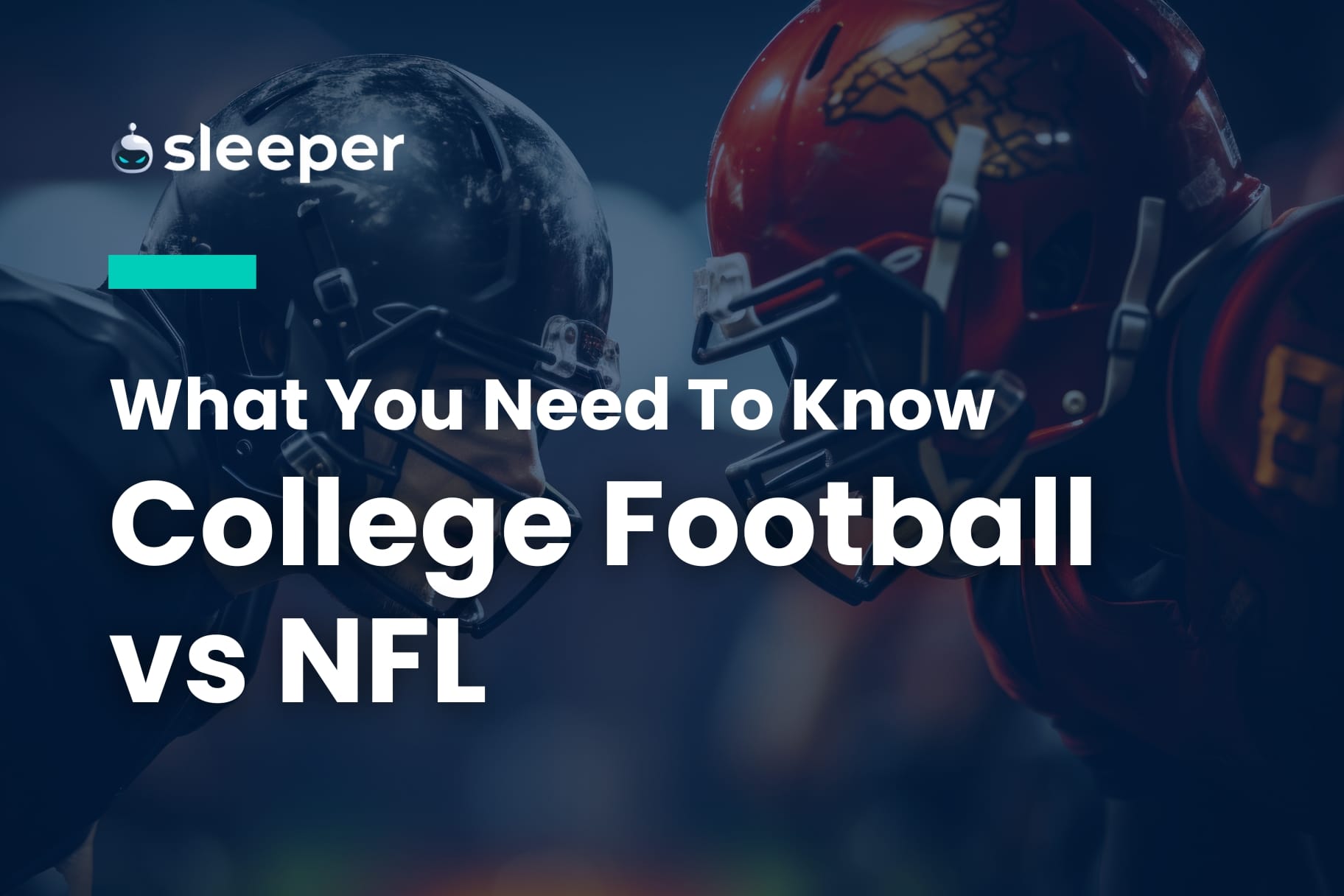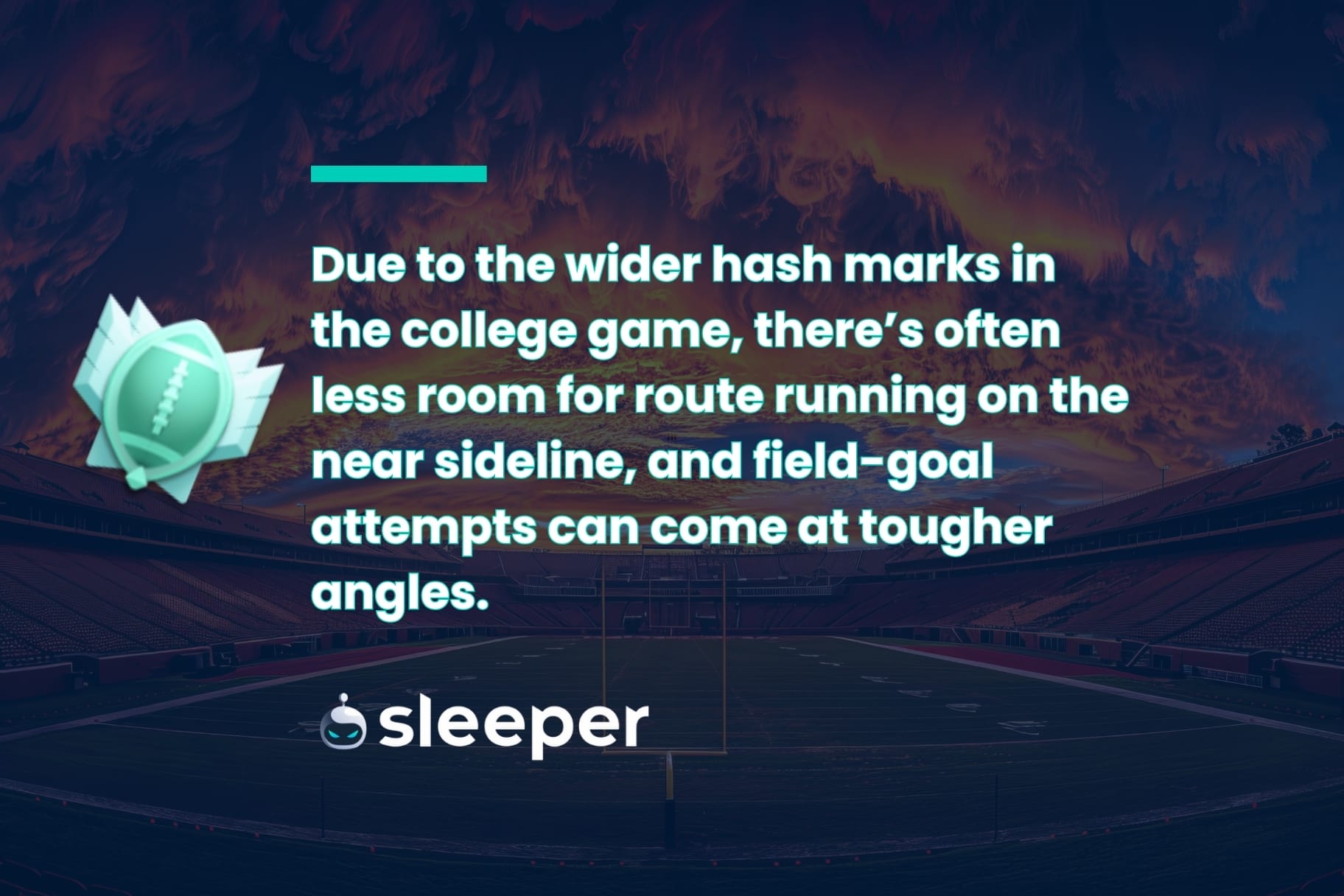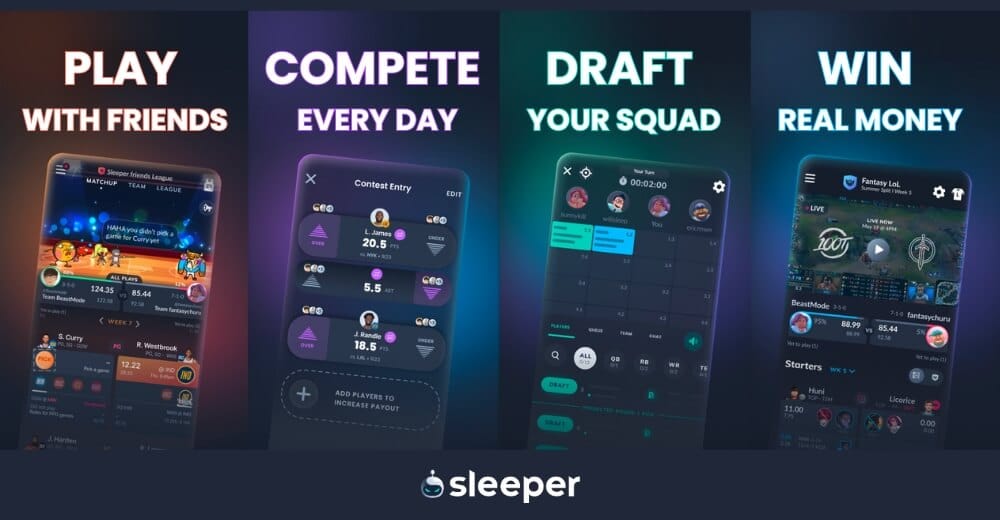College and pro football may look similar to the untrained eye, but there are a myriad of differences between the two levels of America’s most popular sport.

Are you a fan of the National Football League (NFL) looking to get into NCAA football for the first time? Perhaps vice versa? Or maybe you’re just trying to get into football in general and can’t decide whether to go with the one played on Saturdays or the one played on Sundays?
Either way, you’ve come to the right place.
In this guide, we’re going to detail the biggest differences between college football and the NFL to help enhance your knowledge and viewing experience. And if you're considering trying out fantasy college football, there may be something here to help you add to your fantasy trophy case. Let's kick off.
College Football vs. NFL: What Are Their Similarities and Differences?
Field Dimensions and Markings
For the most part, college football and the NFL are played on the same field. This makes it easy for, say, the NFL’s Pittsburgh Steelers and college’s Pitt Panthers to both play their home games at Heinz Field Acrisure Stadium.
At both levels, it’s 100 yards from the front of one end zone to the front of the other, and 53.3 yards from one sideline to the other. The end zones are each 10 yards deep. The field goal posts are located in the back of the end zone, and that kicking target is the same at both levels of football, with the crossbar 10 feet above the ground and the posts separated by 18 feet, six inches. (The NFL’s posts do extend a bit taller at 35 feet in length compared to the college game’s 30 feet, but that’s barely even noticeable.)
The one major difference is the width between the hash marks.
In the NFL, the hash marks are the same width as the field goal posts. In college, however, the hash marks are separated by 40 feet.
Why this matters is that the hash mark is where the ball is spotted for the next snap when a ball carrier goes out of bounds or is tackled between the sideline and the hash mark. Thus, in the college game, there’s often less room for route running on the near sideline, and field-goal attempts can come at much tougher angles.

Game Timing
At both levels, there are four 15-minute quarters on the game clock, with a 40-second play clock in between downs. Also at both levels, each team gets three timeouts in each half.
The NFL has a two-minute warning (full timeout) at the end of both the second and fourth quarters. College football does not.
Prior to the 2023 season, the other massive difference between college football and the NFL timing was that the game clock temporarily stopped on every first down until the down markers (“the chains”) were reset before the next snap. This resulted in college games — particularly the ones with a lot of pass attempts — routinely taking more than four hours to complete, while pro games almost always last around three hours (barring overtime).
After the rule change, college football’s game clock now only stops for first downs in the final two minutes of each half.
Differences in Rules and Penalties
The differences in hash marks and clock stoppages are subtle, but here are five ways that college and pro football can feel like completely different sports.
- Receptions - When catching a pass along the sideline or the back of the end zone, college players need only get one foot down in-bounds for the catch to count. NFL players need both feet (or one knee or one butt).
- Downed by Contact - In the NFL, if the player with the ball falls down on the field of play without being touched by a defender, that player is not down and can get up and continue to run. Not so in college, though. For example, if a quarterback bends down to retrieve a poor snap and touches his knee on the ground while grabbing the ball, the play is over at that moment.
- Pass Interference - Defensive pass interference is a spot foul in the NFL, but only a 15-yard penalty in college football. Thus, if a defensive back interferes with a receiver 45 yards downfield, it’s a 45-yard penalty in the NFL compared to one-third of that in college. Because of this rule, you’ll occasionally see collegiate defensive backs intentionally interfere (or straight up tackle) a receiver if he knows he’s been beaten on a deep ball.
- Targeting - In college football, leading with the crown of the helmet on a tackle or contact with excessive force to the head or neck area — aka “Targeting” — comes with a 15-yard penalty and an automatic ejection (plus a suspension for the first half of the next game if the penalty occurs in the second half). In the NFL, however, there can be an ejection for an especially vicious hit, but fines and suspensions are usually levied by replay review after the game.
- Overtime - Overtime rules might be the biggest difference of all, though the NFL has taken major steps in recent years to ensure that the coin flip isn’t the most important moment of the game. In the pro game, both teams are guaranteed one possession in overtime, after which the team with the lead (or the next team to take the lead) wins. Aside from the sudden death nature, though, the game play is the same as in regulation, beginning with a kickoff and featuring a game clock. In college, each team gets a possession from the opponent’s 25-yard line, with no game clock. If the game is still tied, they do it again. If still tied after two overtimes, the teams alternate two-point conversion attempts until someone wins.

How Many Teams and Players Participate?
For more than two decades, the NFL has had exactly 32 teams. Though the talent gap between the best team and the worst team in any given year may be considerable, it’s not unheard of for the worst team to beat the best team. Due to salary cap rules, there is quite a bit of parity at the professional level.
In college football, where there are way more teams with varying degrees of football program resources, the talent gap between best and worst is far wider. There are currently 130 teams (as of 2024) at the highest level of competition (Football Bowl Subdivision, or FBS) plus a similar number of teams at the next-highest level (Football Championship Subdivision, or FCS). And there’s a whole bunch of lower level teams playing in Division I and II. Occasionally, a good FCS team will compete with and even beat a mediocre or bad FBS team. However, if the best FBS team played the worst FCS team in any given year, the FBS team would likely be favored by seven or more touchdowns.
Historical Fun Fact: FCS Appalachian State’s victory over FBS (and traditional powerhouse) Michigan during the 2007 college football season is still regarded today as one of the biggest upsets in sports history.
In addition to a major difference in the number of teams, there are also considerably more players on a college football roster. The NFL has a hard cap at 53 active players per roster, but college teams can have well over 100 players, counting both those on scholarship and the walk-ons.
Crowning a Champion
Prior to the implementation of the BCS (bowl championship series) in 1998, there was no official national championship game in college football. The champion was simply decided by the various national rankings after bowl games — many of them selected by coaches or members of the media. This occasionally resulted in multiple teams claiming a title. For example, Nebraska, Ohio State and Texas all claimed a national championship in 1970.
After 16 controversial years, the BCS was replaced by a four-team College Football Playoff (CFP) in 2014. The CFP is now a 12-team tournament bracket to select a national champion, on par with the NFL’s 14-team playoff pool from which a Super Bowl winner is crowned.
One key postseason difference still remains: While the NFL has all sorts of rules and tiebreakers in place to determine seeding, the CFP continues to use a selection committee to choose playoff teams and seeding, leading to all sorts of debate and outrage on a weekly basis all season long.
A Few Additional Observations
To any fan of either level, there are of course a great many less tangible differences between college and pro football. Here are some commonly discussed distinctions:
Off-field traditions - A big part of college football fandom is the surrounding hoopla of the gameday experience. School traditions, age-old rivalries, marching bands, live mascots and fight songs are just a few of the often heralded features of the college game that are less a part of the NFL experience.
Student bodies - While the collegiate game is undergoing immense change, most of which is designed to make it more like the NFL, it’s important to remember that teams in college are still composed of students enrolled in the university. A great number of the fans are students, too.
Xs and Os - In the NFL, the high overall talent level means the difference between winning and losing regularly comes down to just a few plays. As a result, coaching systems and schematic formations tend to be similar across the league. In college football, however, there is more strategic diversity and experimentation, making it a “laboratory” for coaching innovation. Novel formations such as the wildcat, triple option, run and shoot, and spread offense originated from the college game.
Stadium size - Perhaps surprisingly to the unacquainted fan, college football stadiums at the most popular programs tend to be a lot larger than those of their professional counterparts. There are more than a half dozen college stadiums that hold over 100,000 fans, while the NFL’s largest venue (Arrowhead Stadium in Kansas City) seats a “modest” 82,500.
Fantasy College Football vs. NFL: What to Consider Before Playing
In addition to the main differences listed above, there are several other things to keep in mind if you’re thinking about getting into fantasy football at either the NFL or collegiate level.
- College fantasy football is nowhere near as widely available as it is for the NFL, so finding and maintaining a league is more work. (Though, perhaps, it’s more rewarding because of that.)
- The player pool in college football is exponentially larger, for better or worse. Competing in a single-conference fantasy league can mitigate that factor, though.
- While NFL teams are required to provide injury reports each week during the season, that’s not the case with college football. That might be changing, though. During the 2023 season, the Big Ten conference required its teams to produce gameday injury reports no later than two hours before kickoff. The SEC has been considering it, too.
- College football has more than its fair share of ‘cupcake’ games, in which even a player with no realistic chance of winning the Heisman Trophy might put up ridiculous stats in a single half. Matchups matter in the NFL, too, of course, but maybe not as much.
- College football generally has more scoring and considerably more rushing yards. A lot of those rushing yards come from dual-threat quarterbacks. Better get yourself a good one of those if you expect to contend.
- Neither level of football is particularly predictable, but college football players are much more prone to volatility from one week to the next. After all, these are 18-22 year olds.
Done properly, college fantasy football can be a lot of fun. However, it has yet to catch on at even a fraction of the popularity that NFL fantasy football has.
Frequently Asked Questions
Who gets more viewers, NFL or college football?
It’s the NFL, and it’s not particularly close. Per Sportico, the NFL was responsible for 93 of the 100 most-watched broadcasts in the 2023 calendar year. Notably, though, college football had three of the other seven and was the only other sport represented.
Why do some people like college football more than the NFL?
Any number of reasons, really. The talent level in the NFL is unquestionably higher, but many simply find college football more captivating because of the traditions, rivalries and environments. The college game also features a much wider array of offensive approaches, from the triple option to the air raid and everything in between.
Could a college team beat an NFL team?
Absolutely not, and it’s ludicrous that this question comes up every time an NFL team flirts with a winless season. Even the best ever version of the Alabama Crimson Tide would get stomped by the worst ever version of the Cleveland Browns. Keep in mind that even the greatest college football teams of all time have a few teenagers on their depth chart.
Final Thoughts
Many sports fans ravenously devour both professional football and college football every fall, while some strictly follow one or the other. There’s really no wrong answer, though. Both forms of American football are wildly popular, and the differences between the two aren’t nearly as night and day as they were just a decade or two ago.
For those looking to do more than just watch football, fantasy football on Sleeper is a fantastic way to get in on the action. You can download the Sleeper App and join a league today. Or you could try out Sleeper Picks for more of a Daily Fantasy Sports fix. All you do is select two or more players and decide whether each will get more or less than their projected stats for that day. Simple as that.




